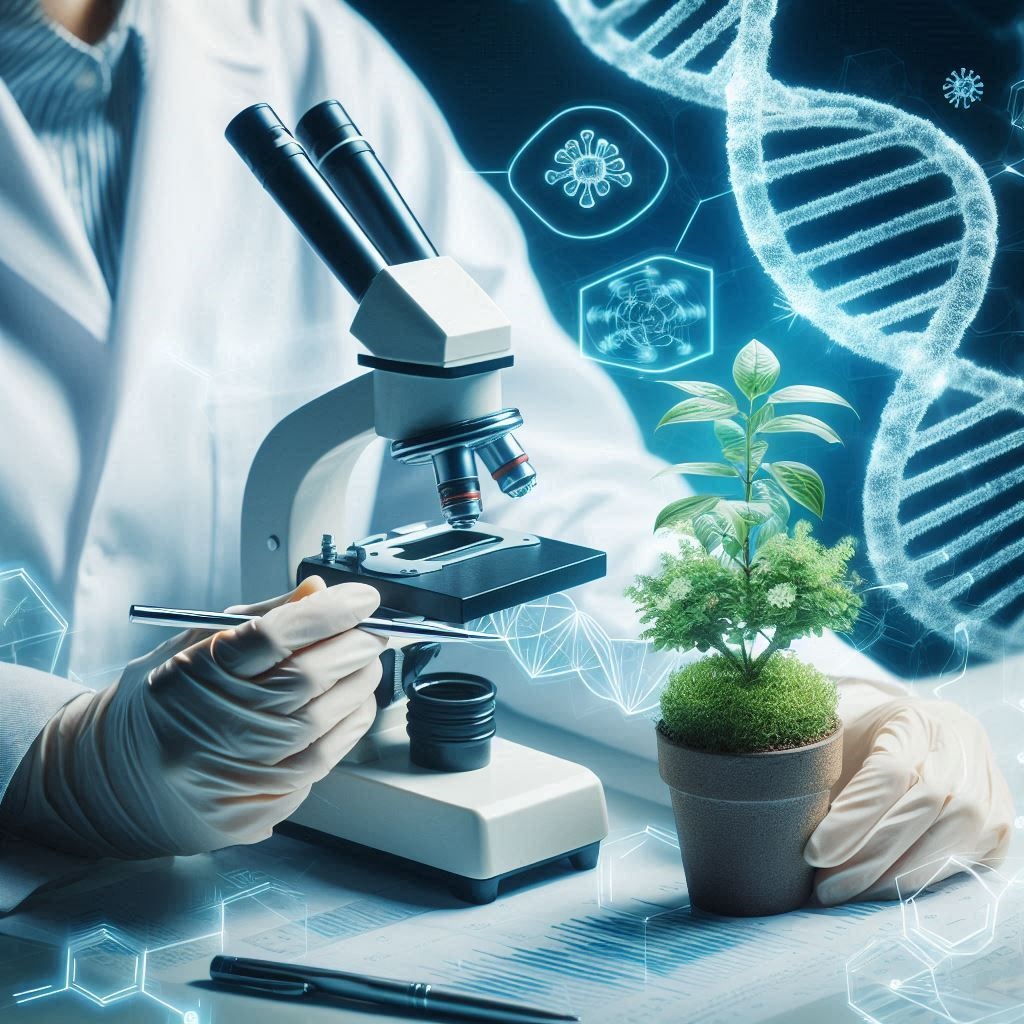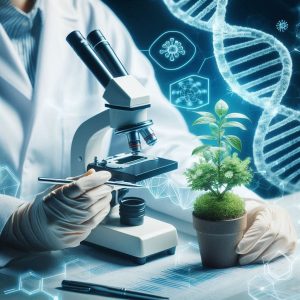What is Plant Genetics?
Plant genetics involves studying the genes, genetic variations, and heredity in plants. It encompasses the analysis of how genes are inherited from one generation to the next and how they influence plant traits. The field integrates molecular biology, genomics, and classical genetics to understand and manipulate plant traits.
Key Concepts in Plant Genetics
Understanding plant genetics involves several key concepts:
- Gene Structure: Genes are segments of DNA that encode instructions for plant growth and development. The structure of genes, including exons and introns, plays a crucial role in their function. For more on gene structure, visit GenomeWeb.
- Genetic Variation: Variations in plant genes can lead to differences in traits such as color, size, and resistance to pests. This genetic diversity is essential for breeding programs and crop improvement. Learn more about genetic variation from Nature.
- Inheritance Patterns: Plants inherit genes from their parents according to specific patterns, such as Mendelian inheritance. Understanding these patterns helps in predicting plant traits and breeding outcomes. Explore inheritance patterns on NCBI.
Gene Structure
Gene structure refers to the organization of DNA sequences within a gene. Genes are composed of exons, which encode proteins, and introns, non-coding regions that are spliced out during RNA processing. Regulatory elements such as promoters and enhancers control gene expression. For a deeper understanding of gene structure, visit NCBI Bookshelf.
Genetic Variation
Genetic variation is the diversity in gene frequencies within a population. This variation is crucial for evolution and adaptation. It arises through mutations, genetic recombination during sexual reproduction, and gene flow between populations. Genetic diversity in plants is essential for breeding programs and crop improvement. Learn more about genetic variation from Nature Education.
Inheritance Patterns
Inheritance patterns describe how genetic traits are passed from parents to offspring. Classical Mendelian genetics explains the inheritance of single-gene traits, while polygenic inheritance involves multiple genes contributing to a single trait. Epigenetics also plays a role, where gene expression is modified without changes to the DNA sequence. Explore inheritance patterns on Genome.gov.
Molecular Markers
Molecular markers are sequences in the genome used to identify genetic variation. They are essential tools in plant breeding, genetic mapping, and biodiversity studies. Common types include RFLPs, SSRs, and SNPs. Molecular markers help in tracking traits, identifying disease resistance genes, and assessing genetic diversity. For more on molecular markers, check SpringerLink.
Genomics
Genomics involves the comprehensive analysis of genomes, the complete set of DNA in an organism. Advances in sequencing technologies have revolutionized plant genomics, allowing for the identification of genes, their functions, and interactions. Genomic studies facilitate crop improvement by enabling the discovery of genes associated with desirable traits. Visit GenomeWeb for the latest in genomics research.
Epigenetics
Epigenetics is the study of heritable changes in gene expression that do not involve changes to the underlying DNA sequence. These changes are often influenced by environmental factors and can affect plant development and stress responses. Epigenetic modifications, such as DNA methylation and histone modification, play critical roles in gene regulation. Learn more about epigenetics from Nature.
Key Concepts in Epigenetics
Epigenetic modifications are chemical changes to the DNA or histone proteins that affect gene expression. The primary mechanisms include:
- DNA Methylation: The addition of a methyl group to the DNA molecule, typically at cytosine residues, which can repress gene expression. This process can be dynamic and responsive to environmental factors.
- Histone Modification: Post-translational modifications of histone proteins that influence the chromatin structure and gene accessibility. These modifications include acetylation, methylation, phosphorylation, and ubiquitination.
- Non-Coding RNAs: RNA molecules that do not code for proteins but play roles in regulating gene expression. Examples include microRNAs (miRNAs) and long non-coding RNAs (lncRNAs).

Epigenetic Mechanisms
Epigenetic mechanisms can be classified into several categories, including:
1. DNA Methylation
DNA methylation involves the addition of a methyl group to the 5th carbon of cytosine residues, commonly found in CpG dinucleotides. This modification typically suppresses gene expression by altering the chromatin structure or recruiting repressive protein complexes.
2. Histone Modification
Histone proteins undergo various chemical modifications that affect chromatin structure. For example, acetylation of histones is associated with gene activation, while methylation can be associated with either activation or repression, depending on the specific histone residues modified.
3. Non-Coding RNAs
Non-coding RNAs, such as miRNAs and lncRNAs, regulate gene expression at the post-transcriptional level. miRNAs can bind to target mRNAs and inhibit their translation, while lncRNAs can interact with chromatin and influence gene expression through various mechanisms.
Applications of Epigenetics
Epigenetics has numerous applications in research and medicine, including:
- Disease Understanding and Treatment: Epigenetic modifications are involved in various diseases, including cancer, neurological disorders, and cardiovascular diseases. Understanding these modifications can lead to novel therapeutic strategies and biomarkers for diagnosis.
- Developmental Biology: Epigenetic mechanisms regulate gene expression during development, influencing cell differentiation and organ formation. Insights into these processes can advance our understanding of developmental disorders.
- Environmental Impact: Environmental factors, such as diet, stress, and toxins, can influence epigenetic modifications and affect health outcomes. Research in this area explores how lifestyle and environmental exposures impact gene expression and disease risk.
Biotechnology
Plant biotechnology uses genetic engineering to modify plants for specific traits. Techniques such as CRISPR/Cas9 allow precise editing of plant genomes to improve yield, resistance to pests, and tolerance to environmental stresses. Biotechnology has the potential to address global food security and sustainability challenges. For insights into plant biotechnology, visit ISAAA.
Table: Key Concepts in Plant Genetics
| Concept | Description | Importance |
|---|---|---|
| Gene Structure | Organization of DNA sequences within a gene. | Determines how genes are expressed and function. |
| Genetic Variation | Diversity in gene frequencies within a population. | Essential for evolution and crop improvement. |
| Inheritance Patterns | How genetic traits are passed from parents to offspring. | Predicts plant traits and breeding outcomes. |
| Molecular Markers | Sequences used to identify genetic variation. | Tools for plant breeding and genetic mapping. |
| Genomics | Comprehensive analysis of genomes. | Facilitates the discovery of genes associated with traits. |
| Epigenetics | Heritable changes in gene expression without DNA sequence changes. | Affects plant development and stress responses. |
| Biotechnology | Genetic engineering to modify plants for specific traits. | Addresses global food security and sustainability. |
Applications of Plant Genetics
Plant genetics has numerous applications that benefit agriculture, horticulture, and environmental conservation:
Crop Improvement
Crop improvement is one of the primary applications of plant genetics. Through selective breeding and genetic engineering, scientists develop crop varieties with enhanced traits such as higher yield, pest and disease resistance, and tolerance to environmental stresses. This ensures food security and agricultural sustainability. For more on crop improvement, visit Agriculture.com.
Disease Resistance
Plant genetics plays a crucial role in developing disease-resistant varieties. By identifying and incorporating genes that confer resistance to specific pathogens, researchers can reduce the reliance on chemical pesticides and enhance crop health. Explore advancements in disease resistance at Plant Pathology.
Abiotic Stress Tolerance
Abiotic stress tolerance involves enhancing plants’ ability to withstand non-living stress factors such as drought, salinity, and extreme temperatures. By understanding the genetic basis of stress responses, scientists can develop crops that are more resilient to climate change. Learn more about abiotic stress tolerance at Crops.org.
Nutritional Enhancement
Plant genetics also contributes to nutritional enhancement of crops. By biofortifying plants with essential vitamins and minerals, scientists can combat malnutrition and improve public health. Golden Rice, enriched with vitamin A, is a notable example. Discover more about nutritional enhancement at IFPRI.
Biotechnology and Genetic Engineering
Biotechnology and genetic engineering allow precise modifications of plant genomes to introduce desirable traits. Techniques like CRISPR/Cas9 enable targeted gene editing, leading to the development of transgenic crops with improved characteristics. These advancements hold promise for revolutionizing agriculture. For insights into biotechnology, visit Biotech.org.
Biodiversity Conservation
Plant genetics aids in biodiversity conservation by understanding and preserving the genetic diversity of plant species. This is vital for ecosystem stability and resilience against environmental changes. Conservation genetics helps maintain genetic resources for future generations. Read more about biodiversity conservation at Conservation.org.
Pharmaceutical and Industrial Applications
Plant genetics is crucial in the production of pharmaceuticals and industrial compounds. Plants can be genetically modified to produce therapeutic proteins, vaccines, and biofuels, providing sustainable and cost-effective solutions. For more on this topic, visit Plant Biotechnology Journal.
Table: Key Applications of Plant Genetics
| Application | Description | Importance |
|---|---|---|
| Crop Improvement | Development of crop varieties with enhanced traits. | Ensures food security and sustainability. |
| Disease Resistance | Creating varieties resistant to pathogens. | Reduces chemical pesticide use, enhances crop health. |
| Abiotic Stress Tolerance | Enhancing resilience to environmental stresses. | Mitigates impacts of climate change. |
| Nutritional Enhancement | Biofortification of crops with essential nutrients. | Combats malnutrition, improves public health. |
| Biotechnology | Genetic engineering for improved crop traits. | Revolutionizes agriculture. |
| Biodiversity Conservation | Preservation of genetic diversity. | Ensures ecosystem stability and resilience. |
| Pharmaceuticals and Industrial | Production of therapeutic proteins, vaccines, biofuels. | Provides sustainable solutions. |
Conclusion
Plant genetics is a vital field that provides insights into the genetic mechanisms underlying plant traits. By understanding these key concepts, scientists and researchers can develop innovative solutions to improve crop yields, enhance disease resistance, and ensure environmental sustainability. The continued exploration of plant genetics holds the promise of addressing some of the most pressing challenges in agriculture and biotechnology.Plant genetics is a dynamic and vital field that underpins advancements in agriculture, environmental management, and biotechnology. By continuing to explore and understand the genetic foundations of plant traits, researchers and practitioners can address global challenges related to food security, environmental sustainability, and health. The ongoing developments in plant genetics promise to bring transformative changes and innovations in various domains.The applications of plant genetics are vast and impactful, driving innovations in agriculture, environmental conservation, and biotechnology. By leveraging genetic knowledge, scientists and researchers can develop resilient crops, enhance food security, and contribute to sustainable development. The continued exploration of plant genetics promises to address global challenges and improve quality of life.
Plant genetics is the study of genes, genetic variation, and heredity in plants. It involves understanding how traits are passed from one generation to the next and how genetic information influences plant characteristics.
How is plant genetics applied in agriculture?
In agriculture, plant genetics is used to develop crops with desirable traits such as higher yield, disease resistance, and tolerance to environmental stresses. This is achieved through selective breeding, genetic engineering, and biotechnological interventions.
What are genetically modified organisms (GMOs)?
GMOs are organisms whose genetic material has been altered using genetic engineering techniques. In plants, this often involves introducing genes from other species to confer beneficial traits such as pest resistance or improved nutritional content.
Is genetic modification safe?
Genetic modification is a highly regulated process, and GMOs undergo rigorous testing to ensure they are safe for consumption and the environment. Numerous scientific studies have shown that approved GMOs are safe to eat and beneficial for agriculture.
How does plant genetics contribute to sustainability?
Plant genetics contributes to sustainability by developing crops that require fewer resources, are more resilient to climate change, and have reduced environmental impact. This includes breeding plants that use water more efficiently and have improved nutrient uptake.
What are the ethical considerations in plant genetics?
Ethical considerations in plant genetics include concerns about biodiversity, the impact of GMOs on the environment, and the socio-economic effects on small-scale farmers. It is essential to balance scientific progress with ethical responsibility and public concern.
Disclaimers on Plant Genetics
While plant genetics offers numerous benefits, it is important to be aware of the following disclaimers:
Unintended Consequences
Despite the precision of genetic engineering, there may be unintended consequences or off-target effects. Continuous monitoring and research are necessary to mitigate any potential risks associated with genetic modifications.
Regulatory Compliance
Genetically modified crops must comply with regulatory standards set by governmental and international bodies. These regulations ensure that GMOs are safe for human consumption and the environment.
Intellectual Property
The development and use of genetically modified plants often involve intellectual property rights. Farmers and researchers must be aware of and respect patents and licenses associated with specific genetic technologies.
I mentioned here that, The information provided in this article is for educational purposes only and is not intended as a substitute for professional advice or scientific research.
Cautions on Plant Genetics
When engaging in plant genetics research or utilizing genetically modified plants, consider the following cautions:
Environmental Impact
Genetic modifications can potentially affect non-target species and ecosystems. It is crucial to conduct thorough environmental assessments and adopt strategies to minimize any adverse effects on biodiversity.
Public Perception
Public perception and acceptance of genetically modified crops vary widely. Transparent communication, education, and engagement with the public are essential to address concerns and promote informed decision-making.
Equitable Access
Ensuring equitable access to the benefits of plant genetics is important. Small-scale and resource-poor farmers should have opportunities to access and utilize genetic advancements to improve their livelihoods.
For more information on plant genetics, visit these reputable sources:




